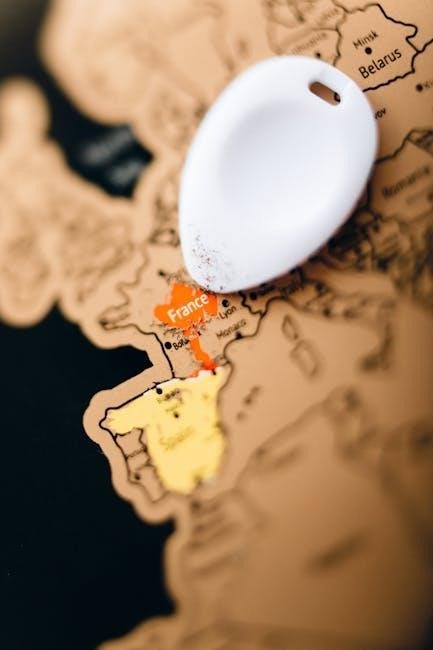Understanding USDA Hardiness Zone 7
USDA Hardiness Zone 7 has average minimum winter temperatures of 0°F to 10°F (-17°C to -12°C). The growing season typically lasts 210 days, with the last frost date around April 15th and the first frost date around November 15th. This moderate climate allows for a wide variety of plants, including cool-season and warm-season crops, making it ideal for diverse gardening. Understanding Zone 7’s climate helps gardeners select appropriate plants and plan effectively for successful growth throughout the year.
Overview of Zone 7 Climate and Growing Season
Zone 7 enjoys a moderate climate with warm summers and cool winters, featuring average minimum temperatures of 0°F to 10°F. The growing season lasts approximately 210 days, with the last frost date around April 15th and the first frost date around November 15th. This climate supports both cool-season crops, like broccoli and kale, and warm-season crops, such as tomatoes and corn. Gardeners in Zone 7 benefit from a versatile environment, allowing for diverse planting opportunities throughout the year. The clear frost dates provide a structured timeframe for planting and harvesting, making it easier to plan and manage a thriving garden.
First and Last Frost Dates in Zone 7
In USDA Zone 7, the last spring frost typically occurs around April 15th, while the first fall frost happens near November 15th. These dates signify critical planting milestones, ensuring gardeners avoid damage to tender plants. The 210-day growing season offers ample time for both cool- and warm-season crops. Knowing these frost dates helps gardeners schedule planting times accurately, maximizing crop success and minimizing weather-related risks. Proper timing based on these dates is essential for a productive garden.
Best Vegetables and Plants for Zone 7
Zone 7 supports a wide variety of vegetables and plants, including tomatoes, peppers, eggplants, broccoli, kale, spinach, carrots, and beets. These crops thrive in its moderate climate.
Cool-Season Crops: Broccoli, Kale, Spinach, and More
Cool-season crops thrive in Zone 7’s moderate climate, tolerating light frosts and cooler temperatures. Broccoli, kale, and spinach can be planted in early February or late August for a fall harvest. Lettuce, carrots, beets, and radishes also excel, preferring spring or fall planting. These crops mature quickly and can be successionally planted for extended yields. They are perfect for Zone 7 gardeners looking to maximize their growing season with fresh, nutritious produce.
Warm-Season Crops: Tomatoes, Eggplants, and Corn
Warm-season crops like tomatoes, eggplants, and corn thrive in Zone 7’s summer heat. Plant these after the last frost date, typically April 15th, when soil warms up. Start seeds indoors 4-6 weeks earlier for a head start. These crops require full sun and well-drained soil. Succession planting can maximize yields, and they are ideal for Zone 7’s long growing season, making them a staple for gardeners seeking hearty summer harvests.
Flowers and Ornamental Plants Suitable for Zone 7
Zone 7 supports a wide variety of flowers and ornamental plants, including Rhododendrons, Crabapple trees, and perennials like Tulips, Forget me nots, and Bleeding heart. Spring-blooming bulbs like Bluebells thrive in Zone 7’s climate. Ajuga and low-maintenance ground covers also excel. Plant these in early spring or fall for vibrant colors and steady growth. These plants enhance landscapes with their beauty and resilience, making them ideal for Zone 7 gardens.
Zone 7 Planting Schedule and Calendar
A Zone 7 planting schedule guides gardeners on when to sow seeds, transplant, and harvest. It outlines optimal planting times for vegetables, flowers, and crops, ensuring maximum growth and productivity throughout the 210-day growing season.
Month-by-Month Planting Guide
- January: Start seeds indoors for early crops like onions and leeks. Plan your garden layout and order seeds.
- February: Plant cool-season crops like spinach, broccoli, and kale. Begin seedlings for tomatoes and peppers indoors.
- March: Direct sow beets, carrots, and radishes. Transplant cool-season crops and plant perennials.
- April: After the last frost, plant warm-season crops like tomatoes, corn, and beans. Direct sow cucumbers and squash.
- May: Focus on heat-loving plants like eggplants and okra. Continue succession planting for ongoing harvests.
- June: Plant summer bulbs and warm-season crops. Maintain soil health and hydration.
- July: Sow seeds for fall crops like cabbage and kale. Succession plant beans and corn.
- August: Plant cool-season crops for fall and prepare soil for winter gardening.
- September: Direct sow spinach, lettuce, and radishes. Plant garlic for spring harvest.
- October: Finish fall planting and clean up beds. Plant bulbs for spring blooms.
- November: Apply winter mulch and protect sensitive plants from frost.
When to Start Seeds Indoors vs. Outdoors
In Zone 7, start seeds indoors 8-10 weeks before the last frost date (around late January to early February) for cool-season crops like broccoli and kale. Transplant these outdoors in mid-March. Warm-season crops like tomatoes and peppers should be started indoors 4-6 weeks before the last frost date (late February to early March) and transplanted after the last frost in April. Direct sow warm-season crops like corn and beans in late April or early May when soil warms up. Use planting charts for specific timing guidance.

Companion Planting in Zone 7
Companion planting enhances growth, deters pests, and improves soil health. Pairing vegetables, flowers, and herbs strategically maximizes space and promotes a balanced ecosystem in your Zone 7 garden.
- Plant marigolds with tomatoes to repel nematodes.
- Basil improves flavor and repels pests near peppers.
- Nasturtiums attract pollinators and deter aphids.
Benefits of Companion Planting
Companion planting offers numerous benefits, including improved growth rates, enhanced flavor, and natural pest control. By strategically pairing plants, gardeners can deter harmful insects, attract pollinators, and optimize space. For example, marigolds repel nematodes, while basil improves tomato flavor and deters pests. This method fosters a balanced ecosystem, reduces the need for pesticides, and promotes healthier plant development. It’s a sustainable and efficient way to maximize garden productivity in Zone 7.
Popular Companion Planting Combinations for Zone 7
In Zone 7, popular companion planting combinations include pairing tomatoes with basil to improve flavor and deter pests, and marigolds with vegetables to repel nematodes. Beans, corn, and squash grow well together, creating a balanced ecosystem. Nasturtiums alongside cabbage and kale deter aphids, while radishes planted near cucumbers help control pests. Borage paired with strawberries enhances fruit production. These combinations optimize growth, reduce pests, and promote a healthy garden environment in Zone 7.

Fall and Winter Gardening in Zone 7
Fall and winter gardening in Zone 7 allows for cool-weather crops like spinach, kale, and Brussels sprouts. Protect plants with mulch and row covers to extend the harvest season.
Extending the Growing Season
Extending the growing season in Zone 7 involves using techniques like cold frames, hoop houses, and frost blankets. These methods protect plants from early frosts and prolong harvest. Succession planting also helps maximize the growing period. By starting cool-season crops in late summer or early fall, gardeners can enjoy fresh produce well into winter. These strategies ensure a longer productive season, even as temperatures drop, making the most of Zone 7’s moderate climate.
Cool-Weather Crops for Fall Planting
Cool-weather crops like broccoli, kale, spinach, carrots, beets, cabbage, lettuce, onions, and radishes thrive in Zone 7’s fall season. These crops prefer cooler temperatures and can tolerate light frosts. Plant seeds for these crops in late summer or early fall, about 8 weeks before the first frost date. Starting seeds indoors in late summer and transplanting them in early fall can extend the harvest season. These crops are perfect for fall gardens in Zone 7.
Tools and Resources for Zone 7 Gardeners
Utilize printable Zone 7 planting charts and gardening apps to plan effectively. Resources like the Kellogg Garden Zone Planting Charts provide detailed guides for sowing, planting, and harvesting.
Printable Zone 7 Planting Charts
Printable Zone 7 planting charts are essential tools for gardeners, providing detailed schedules for sowing, planting, and harvesting. These charts list vegetables like arugula, beans, and broccoli, specifying optimal planting times for indoor and outdoor starts. They also include space for notes, helping gardeners organize their plans. Charts like the Kellogg Garden Zone Planting Guide offer tailored advice, ensuring plants thrive in Zone 7’s climate. These resources are invaluable for maximizing the growing season and ensuring timely harvests.
Recommended Gardening Apps for Zone 7
Several gardening apps are tailored for Zone 7, offering personalized advice and tools. Apps like Garden Plan Pro and Gardening Know How provide zone-specific planting calendars, weather alerts, and pest management tips. Seed Savers Exchange helps track planting and harvesting schedules, while Gardenate offers a database of plants suitable for Zone 7. These apps simplify gardening by providing reminders, soil guides, and disease prevention strategies, ensuring optimal growth and productivity in your Zone 7 garden.
Local Climate Variations and Microclimates
Zone 7 experiences local climate variations, with microclimates like frost pockets and urban heat islands affecting plant growth. Understanding these patterns helps optimize planting strategies for specific areas.
Understanding Local Weather Patterns
Zone 7’s moderate climate varies slightly by region, with average temperatures and precipitation patterns influencing planting decisions. Local weather patterns, including temperature fluctuations and rainfall distribution, play a significant role in determining optimal planting times. Gardeners should consider microclimates and regional variations to adjust their planting schedules, ensuring plants thrive despite local weather irregularities. This localized approach maximizes growth potential and adapts to specific environmental conditions effectively.
Managing Frost Pockets and Microclimates
Frost pockets and microclimates significantly impact Zone 7 gardens. Low-lying areas are prone to frost, damaging plants. To manage frost pockets, use mulch, cold frames, or row covers to protect sensitive crops. Elevate garden beds for better drainage and air circulation. Microclimates, such as south-facing slopes or areas near buildings, can provide warmer conditions, extending the growing season. Plant frost-tolerant varieties in cooler microclimates to ensure resilience and productivity;

Common Mistakes to Avoid in Zone 7 Gardening
Ignoring frost dates risks damaging plants. Poor soil preparation affects growth. Overplanting leads to overcrowding. Not adjusting for microclimates can reduce yield. Avoid these errors for optimal results.
Ignoring Frost Dates
Ignoring frost dates is a common mistake in Zone 7 gardening. Planting tender seedlings before the last frost date (April 15th) risks damage or loss. Similarly, not preparing for the first frost (November 15th) can harm fall crops. Cool-season plants like broccoli and spinach may bolt or die if exposed to unexpected frosts. Always check local frost dates and plan planting schedules accordingly to protect your garden and ensure optimal growth throughout the season.
Incorrect Soil Preparation
Incorrect soil preparation is a frequent error in Zone 7 gardening. Neglecting to test pH levels or amend soil can lead to poor plant growth. Overlooking organic matter like compost reduces soil fertility and drainage. Using excessive or insufficient fertilizer disrupts soil balance, harming root systems. Proper soil preparation ensures optimal nutrient availability, promoting healthy plant development and maximizing yield. Regular testing and amendments are essential for a thriving Zone 7 garden throughout the growing season.